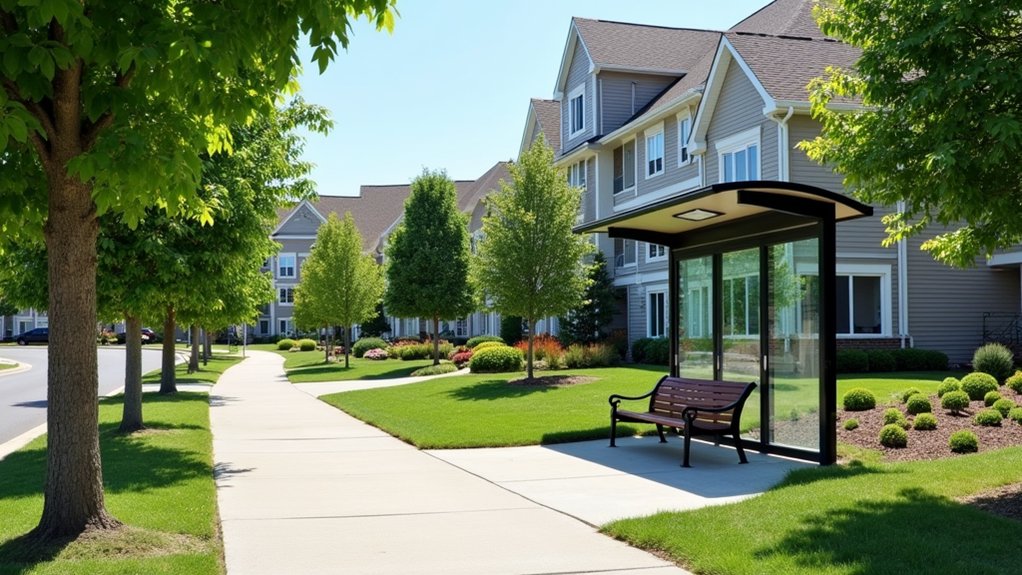How to Choose the Best Residential Care Home

When choosing the best residential care home, start by checking its location for easy visits and proximity to medical facilities. Evaluate staff expertise and their kindness towards residents. Look at amenities like gardens or art classes that match your loved one’s interests. Understand the costs and payment options available. Confirm safety with secure entrances and emergency plans. Stick with us to uncover more tips for making the perfect choice.
Key Takeaways
- Assess location for easy family visits, proximity to medical facilities, and reliable transportation options.
- Evaluate staff expertise, training, and resident interactions for quality care.
- Inspect facilities for comfort, accessibility, and engaging programs tailored to residents’ needs.
- Review costs, payment options, and financial assistance for affordability.
- Ensure safety with secure entrances, 24/7 supervision, and emergency protocols.
Assessing the Location and Accessibility of the Care Home

When you’re choosing a residential care home, start by evaluating its location and accessibility. You want a place that’s easy for family and friends to visit, making sure your loved one feels connected and supported. Check if it’s near familiar neighborhoods or community hubs that matter to them.
Consider proximity to medical facilities for emergencies or routine care—peace of mind is priceless when serving others.
Next, assess how accessible the location is for you and others who’ll provide emotional support. Is public transportation available if driving isn’t an option? Are there safe, walkable paths or parking nearby?
Think about the surrounding environment too—does it offer a calming, welcoming vibe that uplifts spirits? Your role in choosing a home is to prioritize comfort and connection, so take time to visit potential locations. Drive the routes, explore the area, and make certain it feels right for everyone involved. Additionally, ensure that the facility has reliable transportation options that facilitate visits and outings for residents.
Evaluating the Quality of Care and Staff Expertise
After confirming the location suits your loved one’s needs, turn your attention to evaluating the quality of care and staff expertise at the residential care home. You’ve gotta dig deep to guarantee they’ll receive the compassionate support they deserve.
Start by asking about staff qualifications—check if caregivers have proper training and certifications. Don’t hesitate to inquire about staff-to-resident ratios; you want to know there’s enough help to provide personalized attention.
Next, observe how staff interact with residents. Are they patient, kind, and attentive? Trust your instincts—if something feels off, it might be.
Request to see care plans to understand how they address individual needs. Also, ask about ongoing training for staff to handle specific conditions like dementia. Access to memory care services is essential for ensuring that residents with cognitive challenges receive the specialized support they require.
Finally, speak with other families for honest feedback on the care provided. Your loved one’s well-being depends on your thoroughness, so take this step seriously.
Exploring the Facilities and Amenities Offered

As you immerse yourself in exploring the facilities and amenities offered by a residential care home, focus on what’ll truly enhance your loved one’s daily life.
Look for spaces that foster comfort and connection, like cozy common areas for socializing or serene gardens for quiet reflection. Check if they’ve got accessible features—think wide hallways and grab bars—that guarantee safety and ease of movement.
Consider the activities and amenities that’ll bring joy and purpose. Are there engaging programs, such as art classes or music therapy, to stimulate the mind and spirit? For instance, Cedar Ridge Village offers a variety of activities including card games, bingo, and chair exercises to encourage social engagement and community involvement.
Explore activities that inspire joy and meaning. Do they offer enriching programs like art classes or music therapy to uplift mind and soul?
Do they offer nutritious dining options in a welcoming setting? Inspect the cleanliness and maintenance of the facilities to guarantee a healthy environment.
Prioritize homes with amenities that match your loved one’s interests and needs, knowing you’re helping create a nurturing, supportive space where they can thrive every day.
Understanding the Cost and Payment Options
Let’s shift focus to the financial side of choosing a residential care home by exploring the costs and payment options available. As someone dedicated to serving others, you want to guarantee the best care for your loved one without breaking the bank.
Costs can vary widely based on location, level of care, and amenities. Expect monthly fees ranging from a few thousand dollars to much higher for specialized needs. Ask for a detailed breakdown of what’s included—room, meals, medical support, or additional services.
Next, explore payment options. Many homes accept private pay, but don’t overlook long-term care insurance if your loved one has it. Medicaid might cover costs for eligible individuals, so check qualifications. Understanding Medicaid coverage can help you navigate the options available for financial assistance.
Some facilities offer sliding scale fees or financial assistance programs. Research thoroughly and ask questions to find a solution that balances quality care with affordability for those you serve.
Checking Safety and Security Measures

How can you guarantee your loved one’s well-being in a residential care home? Start by inspecting the safety and security measures in place.
Walk through the facility and look for secure entrances, well-lit hallways, and emergency exits. Ask if they’ve got 24/7 staff supervision and surveillance systems to monitor common areas. Check if they maintain updated fire safety protocols and conduct regular drills. You’re there to protect someone dear, so don’t hesitate to inquire about staff training for emergencies.
Next, confirm the home has policies to prevent falls, like grab bars in bathrooms and non-slip floors. Ask about medication management to avoid errors that could harm your loved one. Additionally, ensure that the facility has fall prevention strategies in place to enhance safety for residents at risk of mobility challenges.
Ensure the care home prioritizes safety with fall-prevention measures like grab bars and proper medication management to protect your loved one.
Verify they’ve got a plan for handling medical emergencies, including quick access to healthcare. By actively seeking these details, you’ll provide peace of mind and confirm a safe environment for someone who depends on your care.
Gathering Feedback From Current Residents and Families
Beyond evaluating safety and security, you should also seek insights from those who know the residential care home best. Current residents and their families offer a firsthand perspective on the quality of care and daily life.
Take time to visit the home and kindly ask if you can chat with them. Listen to their stories about the staff’s compassion, the sense of community, and how their loved ones’ needs are met. Are they happy with the support provided? Do they feel respected and valued?
Your heart to serve others drives you to guarantee a nurturing environment, so don’t hesitate to ask specific questions about activities, meals, and emotional well-being. Engaging in meaningful conversations about their experiences can provide deeper insights into the community atmosphere and care provided.
Pay attention to their tone and expressions—genuine contentment speaks volumes. By gathering this feedback, you’re not just choosing a place; you’re guaranteeing a home where dignity and care flourish for those you cherish.
Frequently Asked Questions
What Activities Are Available for Residents Daily?
When considering what activities are available for residents daily, you’ll find a variety of engaging options to enrich their lives.
Check out the schedule at care homes—yep, you’ve gotta see it firsthand! You’ll notice art classes, group games, exercise sessions, and social events.
Don’t hesitate to ask staff about personalized activities. Make certain you’re supporting residents’ happiness by choosing a place where they’ll thrive through meaningful, daily connections.
How Are Dietary Needs Accommodated Here?
Wondering how dietary needs are accommodated?
You’ll be glad to know we prioritize every resident’s unique requirements. Tell us about specific allergies or preferences, and we’ll craft personalized meal plans.
You can trust our dedicated kitchen team to prepare nutritious, tasty dishes that meet medical or cultural needs.
Join us in ensuring everyone feels cared for and nourished—your commitment to serving others shines through in every thoughtful detail we provide!
Can Residents Personalize Their Living Spaces?
Hey, you’re wondering if residents can personalize their living spaces, right? Absolutely, you can help them make their rooms feel like home!
Encourage adding personal touches like family photos, favorite blankets, or small decorations. Check with the staff about any guidelines, but don’t worry—most places love seeing spaces reflect individuality.
Your support in this can truly brighten someone’s day and create a comforting, familiar environment for them.
What Is the Pet Policy at the Home?
When considering the pet policy at the home, you’ll want to ask detailed questions to guarantee residents’ needs are met.
Find out if pets are allowed, what types, and any restrictions on size or breed. Check if there’re designated pet areas or care requirements.
You’re helping create a comforting environment, so advocate for policies that support emotional well-being through pet companionship while maintaining safety for everyone in the community.
How Often Are Family Visits Encouraged?
Hey, you’re wondering how often family visits are encouraged, right?
It’s essential to stay connected with your loved ones, and you’ll be glad to know most homes actively welcome regular visits. Check their specific visiting hours and policies to plan your time.
Don’t hesitate to ask staff how they support family involvement. Your presence can brighten someone’s day, so visit often and show you care with every moment spent together!






